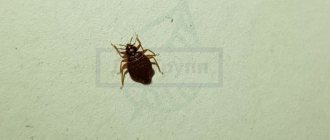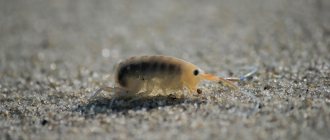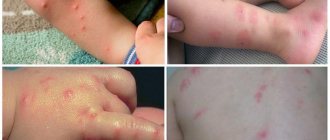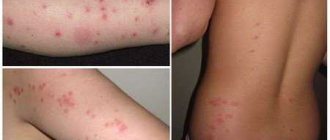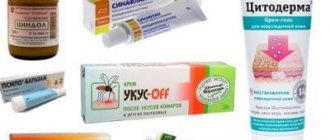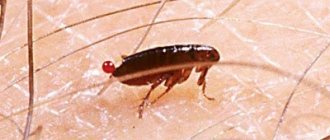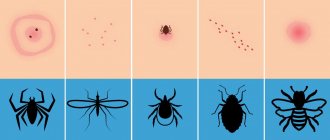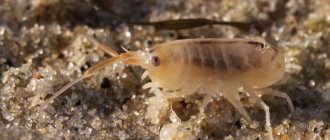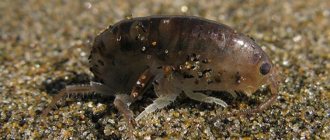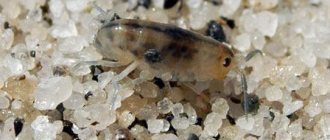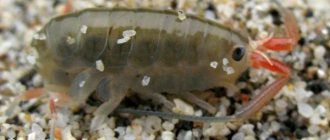Tourists going on vacation to southern countries often receive warnings about the danger of infestation with sand fleas. This type of flea lives only in warm areas of the planet, where until recently there were no Russian tourists, and all information about the dangers lurking was in English. Because of this, serious confusion has arisen, thanks to which people are afraid of completely harmless creatures and do not take into account very dangerous insects - the most insidious of all fleas. Knowing what sand fleas look like in a photo, where they like to hide, you can avoid serious problems that come with getting to know parasites.
Sand fleas
Sand fleas - where they come from and why they are dangerous
The insects belong to the genus Tunga. The second name is considered to be “earthen flea”. They are considered distant relatives of rat and cat parasites. The width of the body does not exceed 1 mm, and the length is 1-2 millimeters.
The brown shell is very strong, so it is unlikely that you will be able to crush a flea with your fingernail. Parasites do not have wings, but are capable of reaching from 14 to 36 cm in a jump. Insect larvae resemble small worms. Habitat: grass, hut floors, trash cans.
In addition to humans, domestic animals such as dogs and cats, as well as cattle such as sheep, horses and mules, become victims of pathogens. Attacks on monkeys, mice, elephants, and pigs are possible.
According to statistics, fleas most often attack those who do not wear shoes. Women suffer from bites less often than men.
A surge in insect attacks is recorded in September. But in January you will hardly find parasites.
By the way, these creatures of God bite people selectively. Out of 5-6 people located close to each other, they can attack only one.
The danger is that as a result of the bite of a female sand flea, you can lose your fingers and even die.
This will be discussed in more detail below.
Ocean tides in Zanzibar
Ocean tides in Zanzibar are very strong: the water recedes a couple of kilometers during low tides. At this time, many still want to swim and go where there is water. They walk for a long time, then swim some more, thinking that the tide has not started. However, he is very cunning. The water does not approach in a single line, as inexperienced tourists expect, but in trickles from all sides, and quite quickly. As a result, the tourist swims and swims, and then looks back - and between him and the shore there are already two kilometers of sea. Such an unpleasant story happens closer to evening. A very scary situation for those who are poor swimmers or are already tired. In this case, it is better to either lie on your back, rest, and then swim to the shore. Or, while swimming, shout loudly so that you are noticed by the shore rangers, who in the evenings specially walk around the beaches in search of such tourists. Whoever they see, everyone will be saved.
How to recognize an insect bite
A tourist who is bitten by a sand flea may not suspect anything for at least several more hours. The maximum incubation period reaches 12 days.
The moment of the bite itself is not felt in any way, and the size of the insect, as mentioned above, does not exceed a few millimeters, so it is difficult to notice the flea.
They live on dry and wet sandy beaches. It doesn’t matter whether the place is deserted or crowded - insects will always find a victim.
How to recognize a sand flea bite?
- The skin begins to itch.
- Most often the extremities itch – legs, especially feet, and arms. Damage to the body - neck, back, abdomen, groin - is possible. The genitals, lips, and back of the head may be affected.
- Over time, the itching becomes more intense, and bite marks become obvious. They are larger in size than mosquitoes, and the affected area swells up like a lump. A clear point is clearly visible in the center - the body of the insect.
- If the degree of attack is low, then there are no more than 5 lesions, and with the maximum form - over 30.
- Severe forms of infestation are more common among people of retirement age.
Those who are not particularly knowledgeable can easily confuse a flea bite with the way a bug bites. But the difference is that after the bite of the latter there are no cones left, and they mainly affect the legs.
Yellow fever in Zanzibar
Another danger that awaits people in southern countries is yellow fever. It is transmitted, like malaria, by a mosquito bite. The virus is endemic in tropical areas of Africa. Good news: Zanzibar is not an endemic region. But you may be asked for a yellow fever certificate when entering Zanzibar, because if you are coming from an endemic region, you can bring the fever to the island. Read more about yellow fever and vaccinations for Zanzibar.
Why are sand flea bites dangerous?
Speaking about the consequences of a bite, it is important to understand whether all sand fleas - both males and females - are equally harmful.
If the victim is bitten by a male, the itching will not be intense. There is no need to fight it; it will go away on its own in a few days.
But if a tourist is attacked by a fertilized female, she will definitely need blood. This is the main danger. The fact is that the sand flea does not just bite, but gnaws into the epidermis.
Most often, she chooses the skin under the nails and between the fingers. Then, due to special enzymes that dissolve the layers of the epithelium, it penetrates even deeper and is absorbed into the blood vessels for further replenishment.
There the flea swells to the size of a small tangible ball, and several hundred eggs mature in it.
The affected area becomes inflamed and ulcers appear. After some time, the insect injects eggs from the wound and then dies.
As a result, the parasitic tropical disease sarcopsillosis may occur. It is also called tungiasis, because, as mentioned above, sand fleas come from the genus Tunga. Complications of the disease are fraught with abscesses and even death.
In addition, insects can cause terrible pathologies:
- sepsis;
- lymphostasis;
- lymphangitis;
- pneumonia;
- loss of nails;
- tissue necrosis;
- thrombophlebitis;
- ulceration to the very bones;
- deformation and even loss of fingers.
The pain from the female's bite is so severe that the victim, whose feet and legs are affected, has difficulty moving.
Lionfish (zebra fish, lion fish)
The lion fish, zebra fish or lionfish is a beautiful striped creature with large fins, inside of which a dangerous poison is hidden. You can meet the fish while diving. She lives near coral reefs, in shallow waters. It is quite possible to observe her from afar - she does not attack herself. But if you disturb a zebra fish, it will release its fin-spines with poison. It will be painful, possible fainting and even muscle paralysis.
Where do they live?
: Red Sea, Indian Ocean
Security measures
: Try not to disturb lionfish while diving. If you run into a dangerous thorn, wash the wound with hydrogen peroxide and, if you find it, treat it with Epsom salts (magnesium sulfate) - this will help neutralize the poison. Then lower it into hot water up to 45 degrees so that it doesn’t burn. It will feel better in 10-15 minutes. After this, disinfect the wound again and take an antihistamine.
Watch the video on how to save yourself from a fish bite
Prevention from sand flea bites
There are a number of ways to avoid encounters with sand fleas:
- Avoid visiting the beach at sunrise and sunset. An early morning boat trip along the edge of the coast is romantic. But it is precisely at this time that the parasites reach their highest activity.
- Apply repellent creams and oils to your skin after each swim. It is important that the repellent is local, it is more effective.
- Wear socks and shoes, and refrain from touching your naked body to the ground.
- Maintain cleanliness in the home.
- Wash your feet in warm water after walking.
- Avoid shady places on the beach.
In addition, before traveling to an exotic country you need to get vaccinated.
Some tourists advise not to lie on the sand at all, but to sunbathe exclusively on a sun lounger. But it is worth considering that fleas can jump high.
Active sun
If mambas and malaria are not particularly relevant phenomena for vacationers in Zanzibar, then the scorching rays of the sun are here every day. When the sky is covered with clouds, it's not so bad. On the last day, we ran out of sunscreen - and we swam without it, but there were clouds in the sky: as a result of two hours of exposure to the sun, I got a little tanned, but did not get burned. However, I do not recommend repeating this experience, since you can turn into boiled crayfish very quickly and unnoticed. Especially in the first days of rest.
What to do if an insect bites you
It is important not to touch the itchy areas. Otherwise, the area of irritation will increase, and liquid will begin to ooze from the bite sites. The most unfortunate way is to give up on the problem without making any attempts to cure it.
You cannot think that the reaction to a bite will go away in a few days. The tricky thing is that the longer the insect is under the skin, the stronger the inflammatory process.
Under no circumstances should you self-medicate or remove the body using improvised means.
The flea is located next to the blood vessels, and if it is accidentally crushed by clumsily pulling it out, complications cannot be avoided.
The female can only be removed surgically. The surgeon removes the insect with tweezers or sterile needles, treats the wound and bandages the operated area. If help is provided on time, the outcome is favorable.
So the best thing to do on vacation is to go to the hospital using your health insurance.
Sea urchins
Walking along the water's edge, you can easily step on a sea urchin hiding in the rocks. The main danger is sharp needles up to 30 centimeters long. If one of them digs into your leg, it could ruin your vacation. The foot swells, the temperature rises, and the wound festers.
Where do they meet?
: coast of North and South America, New Zealand, Red and Mediterranean Seas. They live in rocks and are rarely found on sandy beaches. Often seen on wild beaches.
Security measures
: Rubber swimming slippers can save you. When you enter the water, carefully inspect the bottom and be vigilant while diving. If a hedgehog thorn does attack you, do not try to remove it yourself: it is very fragile and will break easily. It is better to go to the hospital immediately.
If it is not possible to go to the hospital, you can first hold the leg with the thorn in hot water and then carefully pull it out. Treat the wound with an antiseptic.
Preparations for the treatment of sand flea bites
Some of the obvious symptoms indicating a bite are tumors and unbearable scabies. Before applying medicinal products, the wound must be disinfected.
Hydrogen peroxide is suitable for these purposes. After this procedure, you can use medications to help get rid of discomfort. They come in three forms:
- cream;
- repellent spray;
- pills.
Each remedy is effective at different stages, depending on the scale of the disaster and the size of the bite.
The most popular antihistamine creams are:
- yellow balm;
- Phenergan cream;
- Fenistil;
- Compound Dexamethasone Acetate Cream.
They perfectly relieve itching and pain, after which the desire to scratch the body disappears, in addition, they are suitable for children. To eliminate scabies and inflammation, you can also use hormonal agents based on hydrocortisone or sulfur ointment.
Preparations containing Aloe Vera will have a calming effect.
Of the repellent sprays, Mentholatum Remos is the most effective.
Its action lasts up to 6 hours. In addition, it is suitable for children aged 4 years and older. You can also use Calamine lotion. This antiseptic speeds up the healing process.
Tablets are divided into antihistamines and antibiotics. Among antihistamines, cetirizine hydrochloride 10 mg (Cetirizine Hydrochloride) is effective. Suprastin and Zyrtec have less effect. These medications reduce scabies, but are contraindicated in children under 7 years of age.
Antibiotics reduce the affected area and itching, but act more slowly than creams.
For example, when taking Hapenxin XX 500mg in capsules, changes become noticeable only after 5-7 days, and complete recovery occurs after 7-8 weeks.
As a rule, both types of tablets are used in combination. The downside is that medications can cause drowsiness.
Plankton allergy
An allergy is the body's reaction to an antigen from the external environment. As a result, an overactive immune response occurs, leading to characteristic external manifestations. An allergic reaction can occur to various external factors, both external (interacting with the skin) and ingested (entering the intestines with food), which is characterized by the appearance on the body of rashes of various shapes and sizes, a feeling of itching (however, not always) and symptoms from the respiratory system and gastrointestinal tract. This is a fairly common problem in Thailand - about a quarter of holidaymakers experience these symptoms. Typically, the cause of the allergy remains unknown. However, in the absence of life-threatening symptoms, the principles of treatment are approximately the same and finding out the cause does not make much sense - it is better to do this upon arrival home.
Causes of allergies in Thailand:
- Food products - especially nuts, eggs, soy, citrus fruits, fish, shellfish. For example, fish sauce, oyster sauce and shrimp paste are essential ingredients in Thai cuisine, and fermented fish sauce is often used in place of salt. Thai chili paste is an important ingredient in tom yum and tom kha soups, as well as some salads and stir-fries. It contains dried shrimp or shrimp paste. Here is a typical example of the presence of seafood in food, even when it seems that there is none there. Therefore, it is better to eat steamed rice instead of fried rice - minimizing the likelihood of seafood allergies. If you are allergic to peanuts, you should avoid eating pad thai, catfish, and tom yum noodles and rice flour pancakes with various fillings - they will always contain traces of peanuts.
- Insect bites, ticks.
- Medications. As a rule, these are antibacterial agents.
- Infections. About 70% of allergy cases are associated with a viral infection (this is why parents cannot understand what caused the rash, because household chemicals and diet have not changed). In this case, the occurrence of an allergic reaction is associated with the immune response to an infectious allergen.
- Contact allergy. Household chemicals, cosmetics, latex, etc.
- A special type of allergic reaction is sun allergy or photodermatosis, which most often appears on the 3-5th day of rest. It resembles a normal rash that covers almost the entire body. Slight swelling of the skin and a slight increase in temperature may be observed. The reason is a disturbed reaction of the body to prolonged exposure to the sun, especially typical for residents of the northern part of Russia who abruptly go from winter to summer.
- Exacerbation of systemic diseases - mastocytosis, vasculitis, lupus and others.
Allergy symptoms:
- On the skin side – itching, redness, rash (of varying sizes, there may be blisters), swelling. The rash appears in the form of plaques or spots that rise above the surface of the skin and have a reddish tint. The size of such spots can be different and, as a rule, ranges from 1-2 mm - 1-2 cm. The rash is accompanied by itching, which gets worse at night.
- From the respiratory system - sneezing, runny nose, cough, itchy throat, change in voice and difficulty breathing.
- On the part of the eyes - lacrimation, redness, constant itching and burning sensation.
- From the gastrointestinal tract - nausea, abdominal pain, diarrhea.
- General – weakness, irritability, fever, etc.
Symptoms requiring emergency hospitalization:
They usually talk about the development of an anaphylactic reaction, which can be fatal if emergency medical care is not provided.
- Difficulty or disturbance in breathing.
- Voice change.
- Weakness.
- Dizziness.
- Lethargy.
- Fainting.
- Reduced blood pressure.
- Strong feeling of heartbeat.
- Swelling in the neck, lips, and mouth.
- Severe abdominal pain and/or vomiting.
Allergy treatment in Thailand:
In the case of anaphylaxis, if it is impossible to obtain qualified emergency care and there is no syringe with adrenaline, then you should pray, and also take steps aimed at reducing the dose of the allergen - in the case of food consumption - spit it out or induce vomiting, in case of a bite - remove the sting, put it on it place ice, apply a tight bandage above it - no more than 30 minutes. If you feel weak or dizzy, place the person on their back with their legs raised above head level. And most importantly, immediately go to the nearest hospital or at least a pharmacy.
- Antihistamines are divided into 3 generations. The first and second generation of drugs have a lot of side effects: drowsiness, weakness, fatigue, headache and dizziness. In addition, they must be taken 2 times a day and the effect does not occur immediately. Group 3 drugs are practically free of side effects, have a rapid onset of action and need to be taken only once a day. Suprastin (chloropyramine) – local analogues: chlorpyrimine; tavegil (clemastine) – local analogues: clemastine; fenistil (dimetindene) - can be used in children starting from 1 month - local analogues: fenistil; Claritin, Claridol, Loragexal, Loratadine - local analogues: allerdine, allersil, carinose, claritex, halodin, loranox, lordamin, lorsedine, rityne; cetrin, zyrtec, cetirizine - local analogues: alerest, cetihis, fatec, setin, zetrix; telfast, fexadine (fexofenadine) - local analogues: bosnum, fenafex, fexotine, telfast, vifas; aerius, desloratadine-teva (desloratadine) – a local analogue of aerius. Pregnant and breastfeeding women can use drugs based on loratadine and cetirizine - listed above.
- Hormonal preparations in the form of ointments. Tetraderm, silcaren (mometasone) - local analogues: elomet, momate, novasone.
- General hormonal drugs are used for severe allergies. These are drugs containing prednisolone. These drugs are prescribed only after consultation with a doctor.
- Ointments combining an antibiotic and a hormone. They can be used if it is not entirely clear whether this is a purely allergic reaction or whether there is a combined infection - for example, tick or insect bites. These are drugs like Fuc />
If for some reason medications are not available, you can relieve symptoms using the following methods.
- Cold compress. To do this, you need to take any cloth (towel, clean T-shirt or sheet), wrap it in ice or wet it with cold water and apply it to the most intensely itchy areas of the skin. It must be changed every 7-10 minutes until symptoms decrease.
- Oatmeal compress. Take oatmeal, grind it to a powder, mix it with water at room temperature and apply the resulting mixture to the affected areas.
- Compress with baking soda. You need to mix 2-3 teaspoons of baking soda with water, stir to a paste consistency and apply to the areas of the skin that itch the most.
Allergy prevention:
To prevent and then treat allergies, it is necessary first of all to identify the cause. But very often it is impossible to identify the cause while on vacation and you must wait until you return home. Therefore, the basic rules for vacationers in Thailand are:
- Avoiding possible food allergens listed above.
- Limit contact with animals.
- Wet cleaning of a hotel room or rental housing at least 2 times a day.
- Getting rid of items that can accumulate dust - carpets, bedspreads, etc.
- Availability of a syringe pen with adrenaline in case of existing cases of anaphylaxis or angioedema.
Traditional methods of getting rid of the consequences of bites
In addition to medications, there are effective folk remedies that can eliminate itching after a bite. Their essence boils down to the effect of high temperatures on the affected area.
- If you direct a hot stream from a hairdryer to the bite site, you may feel relief. True, you need to blow carefully. Otherwise, you may get burned.
- Instead of a hairdryer, you can use hot cutlery - knives, spoons or forks. The device is placed in boiling water for a couple of seconds, and then applied to the affected area.
- Another alternative is a hot shower. You need to turn up the temperature, which is almost unbearable to endure. Of course, the skin will turn red, but after it is dried and moisturized with cream, the itching will go away.
Jellyfish
Air creatures can be incredibly dangerous. Their stinging cells contain poison. The most dangerous jellyfish you can encounter on the beach are the yellow round box jellyfish and the “Portuguese man-of-war”, a beautiful blue-violet color.
Jellyfish "Portuguese Man of War"
Box jellyfish (sea wasp)
Where do they meet?
: beaches of Southeast Asia, Mediterranean Sea, Indian and Pacific Oceans.
Security measures
: try not to go to the beach after a storm - jellyfish wash up on the shore and the chance of meeting them is very high.
If you are stung by a jellyfish, call a doctor. After a bite, do not rub the wound or pull out the sting. While you wait for help, you can apply a dry compress and rinse the area with sea water. And forget the tales of miracle cures of urine, vinegar and alcohol!
Insects with which the sand flea can be confused
It's good to know the enemy by sight. It’s even better to distinguish between its other varieties. In Thailand, other insects can be mistaken for sand fleas. True, their bites are not so dangerous.
- Mosquitoes and midges. Their bites are very similar to flea bites, but are essentially harmless.
- Ants. They can take revenge on a person if he accidentally crushes them with his hand or body. They usually crawl on people by accident. An ant bite leaves a lump that may hurt for some time.
- Bedbugs. They are extremely rare. Mostly in bungalows and not very well maintained hotels. After bedbugs, a “path” of bites remains, but the affected areas never swell.
Fire worms
Despite the creepy name, they look quite cute: a bright orange caterpillar with fluffy white bristles. The size can reach 40 cm, but usually it is about 10 cm. Some wildlife lovers find it difficult to restrain themselves from grabbing the handsome man in their hands. This should not be done under any circumstances: the worm instantly parts with its bristles, they scatter in the water and stick straight into your hands. The spines contain capsules containing poison containing a neurotoxin. The skin turns red, swells, dizziness and nausea begin.
Where do they meet?
: Mediterranean Sea, Adriatic coast.
Security measures
: Do not swim on wild beaches - fireworms accumulate right in the shallow water between the rocks. They themselves are timid and non-aggressive; they will not attack unless disturbed. If you are diving on an unequipped beach, wear rubber slippers - they will protect your feet.
If you are injured by a fireworm, you need to remove the poison capsules. Use tweezers if you see spines, or regular tape if the bristles are not visually visible. After this, the wound should be wiped with alcohol. And don’t forget to see a doctor - if the affected area is large, you will be prescribed antibiotics.
